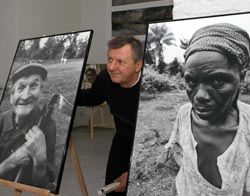Ukrainian photojournalist finds things in common between Hutsuls and Africans

The Kyiv-based Ya Gallery recently showcased the works of Ukrainian photographer Oleksandr Klymenko, who is a regular participant and prizewinner of The Day‘s photo competitions. The exhibit, part of an art project called “Demonstration,” mostly featured the photographs from his well-known series called “Wild, Wild West,” which was first shown during the Lviv Book Fair this year. The photographer won the right to participate in Ya Gallery’s project as a prizewinner of The Day‘s 10th photo competition.
It took Klymenko several years to complete the “Wild, Wild West” series, which took him to the western Ukrainian regions of Ivano-Frankivsk, Zakarpattia, and Chernivtsi and the West African states of Liberia and Sierra Leone. Klymenko arrived on the African continent together with a helicopter detachment of Ukrainian peacekeepers.
Photographing the everyday life of the Hutsuls of western Ukraine and African peasants, Klymenko found many parallels between these two seemingly different peoples.
“I took pictures on both continents, and suddenly I realized that these people from two different continents have a lot in common. For one thing, they are similar in their straightforwardness. I would like to go back to Africa, although it is a pretty scary place with a lot of disease. In his novel The Dogs of War Frederick Forsyth says that Africa stings as painfully as the tsetse fly, and it leaves its venom in you, forcing you to go back there again. It is a drug.”
Klymenko has done plenty of other interesting work, including documenting the events of 1991 on the Maidan and in the Ukrainian parliament.
Klymenko has been a professional photojournalist for the past 22 years. He has worked for the newspaper Silski visti and since 1991 he has been with Holos Ukrainy. He has published two photo albums: Ukraina. 10 rokiv postupu (Ukraine: 10 Years of Progress) and Myrotvorcha diialnist ukrainskoho viiska. Pershe desiatylittia (The Peacekeeping Activity of the Ukrainian Army: The First Decade). His photos have been published in the authoritative German weekly Der Spiegel, and he has participated in many photography shows in Ukraine and abroad.
“Photojournalism is rock, while staged photography is kitschy pop,” said Klymenko, adding that photojournalism is his life’s work. He is also an eager participant in The Day‘s photo competitions. “I started taking part in this contest virtually from its inception, and I can say that this is the only serious, nationwide - and I mean nationwide - photo competition. Ukraine has no other contest like it.”
Despite his impressive career, Klymenko believes that his main epoch-making works lie in the future. “The best is still ahead, and at some point I will take a brilliant picture that will be featured by World Press Photo as their number-one picture. This will probably be a photograph showing some human tragedy. This is actually how we need to live because if you say you have accomplished everything, you need to switch to something different.”






